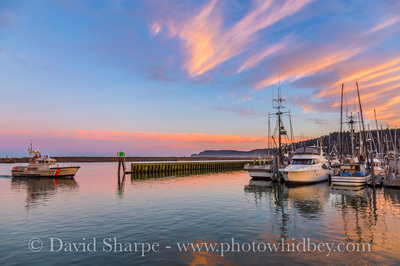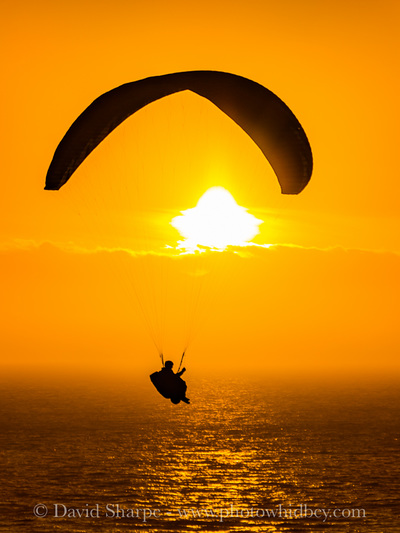 An Interview with Landscape and Fine Art Photographer David Sharpe 1. What equipment to do you use? What camera? I use a beat-up Canon 6D DSLR camera and a collection of Canon L-series lenses. I firmly believe that good photos can be made with any camera - it’s not about the equipment. The photographer chooses what to include in the frame and how to compose the image, as well as selecting exposure settings to capture the scene in an artistic way. My camera has been dropped, tossed in the back seat of my car, and generally abused. It’s missing the mode indicator (fortunately I can still change modes) and the on/off switch is permanently “on”, but it still works fine. Money is better spent on buying good lenses and gaining knowledge than it is on constantly having the latest, greatest camera. 2. Technical Advice? That’s a tough question to answer - technical advice should be targeted for each individual photographer, depending on their needs. I suppose the best advice I can give is to find a mentor - someone you admire who is willing to teach and share their experiences. We do this in the medical field, as well as many other professions. In The Arcanum we use a Master/Apprentice relationship in which students work in small groups with a mentor who guides their learning as they work through set challenges. I began as an Apprentice, and am now a Master in The Arcanum, with my own students literally all over the world. I frequently meet with these students one-to-one via Google Hangouts to review their images and offer personal advice and suggestions for improvement. It’s a real thrill to see the measurable progress these students make as time goes by. At the same time, I have my own mentors in the Arcanum that I often share ideas and struggles with. 3. Creative Advice? I suppose my best creative advice is to SLOW DOWN and really think about what you’re doing in the field. One of the challenges I give my students is called the “Sniper Challenge” - one shot, one kill (OK, I learned everything I know about snipers from that Tom Beringer movie.) The student has to describe in advance an image they want to make and tell me what they’re going to photograph and when, as well as their anticipated camera settings and lens choices. Then they are required to go make that image, but they only get to take one photo, then have to pack up and walk away. The final step is to share that image with me and tell me what worked and what didn’t - and what they’d do differently if they had another chance. Many of us (myself included) get so wrapped up in the scene before them that they start snapping photo after photo in hopes of getting something good. 4. Post Processing - Favorite techniques? Many people mistakenly believe that post processing - or “photoshopping” a photograph is cheating, but in fact it is absolutely a recognized part of the process of creating an image. The great Ansel Adams - perhaps the most famous landscape photographer ever - used dodging and burning techniques to alter his images in the darkroom. Today the darkroom has been replaced by a computer, and we can really tweak our images to create just the look we want. As far as a single favorite technique, I guess I’d have to say it’s removing halos using Photoshop’s clone tool set on darken mode - that sounds confusing, but I made a video which shows how to do this. It’s a quick and easy technique that I’ve been using for some time. You can watch it here: https://youtu.be/EnwHZmX_35I 5. Post Processing - Software used? I’m a big fan of Adobe Lightroom. I do 90% or more of my editing in Lightroom, exporting to Photoshop or other applications when needed for specific tasks. I find that Lightroom is incredibly powerful and allows me to do almost anything I need - and each new upgrade adds features that make it even more powerful. Adobe offers Lightroom and Photoshop subscriptions bundled together for around $10 per month, with free upgrades to the latest version whenever new features are added. I was skeptical about the subscription plan at first, but I’ve found it much less expensive than buying both of these software applications along with paying for periodic upgrades. 6. Technical challenges? Perhaps the biggest issue I struggle with is creating natural-looking blends of multiple exposures using luminosity masks. I love this technique, because it can create amazing images by blending several shots into a final image that looks more like what my brain remembers seeing on scene. I’ve followed Sean Bagshaw’s work with this technique, but still feel I haven’t fully mastered it as much as I’d like to. This is a technique that I’m actively working to develop. 7. Creative Challenges? Perhaps the biggest challenge I face creatively is finding a unique image to make. My days of hiking out into the wilderness are long past, and I now travel in an RV (I love a hot shower and a comfortable bed after a day of photographing). This means that many of the places I photograph are easily accessible to everyone else with a camera - so in order to make my images stand out I need to find a unique angle or lighting situation. The amusing thing is that I’m often followed by other photographers who want to take advantage of the unique view I’ve discovered. Just yesterday I was in the Skagit daffodil fields making images of the sunrise over the brilliant yellow fields. There were plenty of other photographers nearby making the same image, but when I walked back to my car I noticed that the Olympic Mountains behind us were just being illuminated by the morning sun. Not a single photographer had noticed this yet, and there was a wonderful daffodil field in the foreground, making this a unique perspective. I set up and started composing my shot, only to be joined by 6 other photographers who had noticed me facing the other way across the street and hurried over to take advantage of my “discovery”. 8. Artistic signature that conveys your style? When I first picked up a camera, I avoided including anything man-made in my images, preferring the undiluted beauty of nature. Over the years though, my style has evolved and now I actively look for people or signs of human presence to include in my photographs. I think this gives the viewer something to identify with in the image, and helps to draw them in. Even other photographers are fair game for inclusion in my images. The key is that I rarely have the person interacting with me - these are not portrait sessions. Rather, a silhouetted figure watching the sun set really captures the feeling of “being there” that I want to convey to the viewers. A path winding through a prairie, a dock on a placid lake, even piles of trash found in an otherwise pristine forest all evoke a reaction from viewers. 9. Favorite Subject? I love to photograph anything I can find in the outdoor setting. Living here on Whidbey Island I find that I spend a lot of time making seascape images - capturing the rugged landscape and moving water excites me. Like many landscape photographers, I also look for interesting lighting that is usually found at the beginning and end of the day. In fact, my Arcanum teaching group is called The House of the Rising (and Setting) Sun. 10. Favorite Location? There are so many amazing locations everywhere I’ve travelled that it can be tough to pin this down to a single spot. I love the local scenes of Central Whidbey, and I regularly photograph these as a means of practicing my craft - a necessary part of improving as an artist. If pressed to name a single location, I guess I’d have to say the outer Olympic Coast - La Push, Second Beach, Ruby Beach and Kalaloch all offer amazing locations that are easily accessible. Readers interested in knowing more about Dave Sharpe are invited to contact him at strongerphotos@gmail.com, or to check out his website at www.photowhidbey.com If you’d like more info about the Arcanum or would like to join Dave’s teaching cohort, contact him directly.
David is a resident of Whidbey Island but travels throughout the Pacific Northwest (and beyond when possible) making images and capturing the light anywhere he can. Dave also works part-time as an ER nurse, but his true passion is photography. Fortunately he is able to travel often with his wife in a 24’ RV, exploring all the great places our region has to offer. Dave’s images are available both online and at Coupeville Coffee and Bistro where he displays his work. But his real love is teaching others how to make stronger photographs. He is a Master in The Arcanum, an online academy offering mentoring and guidance for photographers all over the world, founded by the well known Trey Ratcliffe and others. (www.thearcanum.com)
0 Comments
Your comment will be posted after it is approved.
Leave a Reply. |
AuthorPhotography and photographers... A look at both. Blame it on the light. Archives
June 2017
Categories
All
|










 RSS Feed
RSS Feed